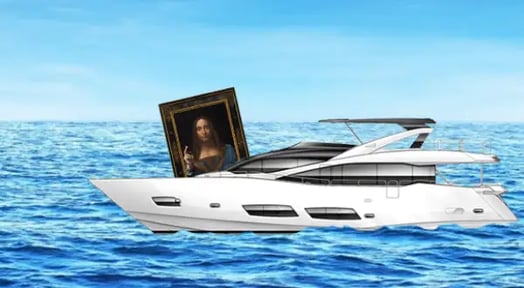The Salvator Mundi — a portrait of a softly smiling Christ allegedly painted by Leonardo da Vinci in 1500 AD — became the world’s most valuable painting when it sold for $450.3m in 2017.

Then, it disappeared.
It’s a surprisingly common occurrence in the world of high-profile art: Privately owned paintings briefly go on public tours to drum up interest — and then sell to mystery buyers and disappear from public view.
But now, thanks to an unorthodox art sleuth, the mystery of the Mundi has been solved. The Salvator Mundi — like many of the world’s finest paintings — ended up aboard a billionaire’s yacht.
The strange saga of the Mundi
For centuries, the Mundi lorded over the royal residences of kings of France, England, and Scotland. But in the 18th century, it fell into obscurity.
In 1958, the by-then-unknown Mundi sold for the equivalent of $1.4k. But when it was resold in 2011, the lordly Leonardo painting was recognized — and it rapidly regained its rightful royal reputation.
In 2017, the world’s last private da Vinci sold to a private buyer, sending waves rippling across the murky waters of the art world.
The Mundi’s roundabout return to its royal roots
After the sale, reports soon bubbled to the surface that the Mundi’s buyer was an obscure Saudi prince.
A few months later, the Saudi royal family appointed that same prince as the kingdom’s first “minister of culture,” and a tourism official announced the painting would go on display at the Louvre Abu Dhabi.
Instead, the painting again disappeared.
Now, the Mundi has resurfaced aboard the superyacht of Mohammed bin Salman, crown prince of Saudi Arabia — likely the plan all along.
The strange world of superyacht super-art
Saudi Arabia’s crown prince isn’t the only billionaire to consign the world’s artistic wonders to a waterborne wealth-warehouse: A few months ago, The Guardian reported that many of the world’s wealthiest have basically turned their mega-yachts into marine museums.
According to the report, some yachts carry as many as 800 pieces of art (often worth multiple times the vessels’ value).
We know what you’re thinking: Renaissance-era art and rough seas — what could go wrong?
But seawater may be the least of the Mundi’s problems: Art advisors say they’ve seen boat-bound art stained by cereal spills, damaged by champagne corks, and even sliced into pieces to fit inside the jet-ski room.

